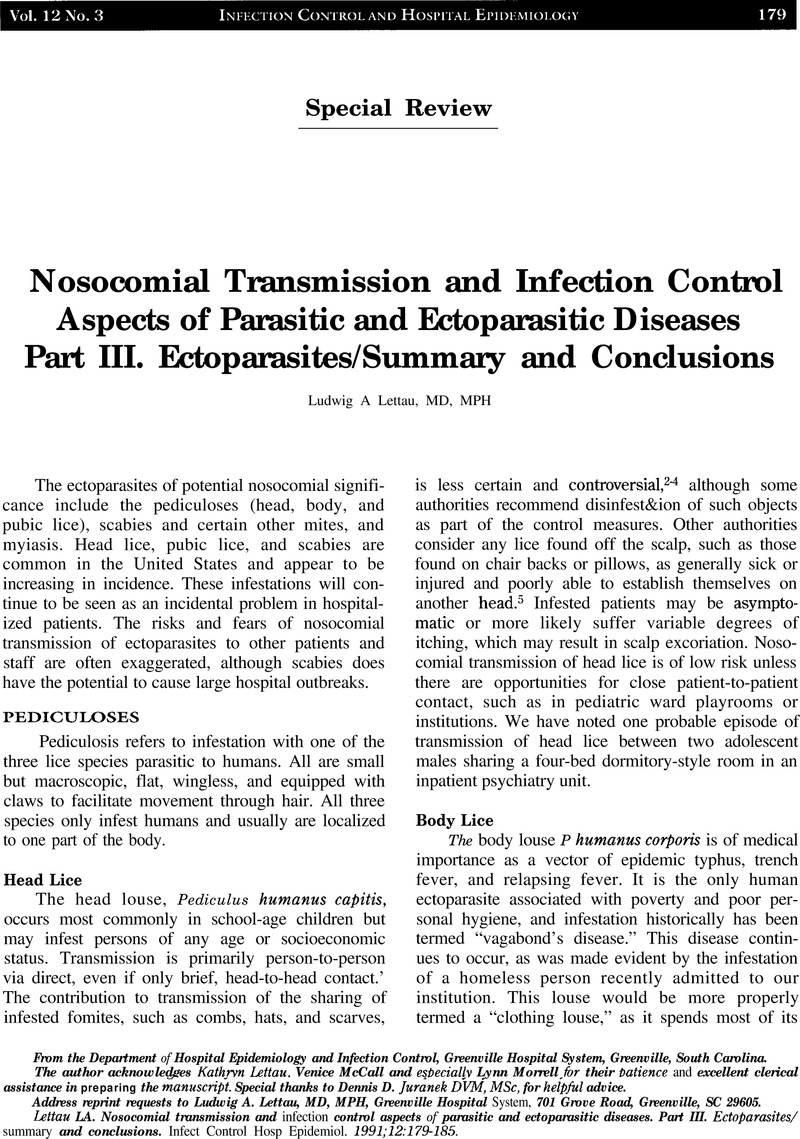Crossref Citations
This article has been cited by the following publications. This list is generated based on data provided by Crossref.
Pastenak, Jacyr
Richtmann, Rosana
Ganme, Antonio P.P.
Rodrigues, Edwal A.C.
Silva, Fermina B.M.
Hirata, Maria de Lurdes
and
Ciosak, Suely
1994.
Scabies Epidemic: Price and Prejudice.
Infection Control & Hospital Epidemiology,
Vol. 15,
Issue. 8,
p.
540.
Pasternak, Jacyr
Richtmann, Rosana
Ganme, Antonio P. P.
Rodrigues, Edwal A. C.
Silva, Fermina B. M.
de Lurdes Hirata, Maria
and
Ciosak, Suely
1994.
Scabies Epidemic: Price and Prejudice.
Infection Control and Hospital Epidemiology,
Vol. 15,
Issue. 8,
p.
540.
Jimenez-Lucho, Victor E.
Fallon, Florence
Caputo, Connie
and
Ramsey, Karol
1995.
Role of prolonged surveillance in the eradication of nosocomial scabies in an extended care veterans affairs medical center.
American Journal of Infection Control,
Vol. 23,
Issue. 1,
p.
44.
Mielke, U.
1997.
Nosocomial myiasis.
Journal of Hospital Infection,
Vol. 37,
Issue. 1,
p.
1.
Herwaldt, Loreen A.
Pottinger, Jean M.
Carter, Cheryl D.
Barr, Brenda A.
and
Miller, Elyse D.
1997.
Exposure Workups.
Infection Control and Hospital Epidemiology,
Vol. 18,
Issue. 12,
p.
850.
Sharbaugh, Robert J.
1997.
Scabies: An itchy problem.
Home Care Provider,
Vol. 2,
Issue. 3,
p.
115.
Bolyard, Elizabeth A.
Tablan, Ofelia C.
Williams, Walter W.
Pearson, Michele L.
Shapiro, Craig N.
and
Deitchman, Scott D.
1998.
Guideline for Infection Control in Healthcare Personnel, 1998.
Infection Control & Hospital Epidemiology,
Vol. 19,
Issue. 6,
p.
407.
Amitay, Moshe
Efrat, Moshe
McGarry, John W.
and
Shinwell, Eric S.
1998.
NOSOCOMIAL MYIASIS IN AN EXTREMELY PREMATURE INFANT CAUSED BY THE SHEEP BLOWFLY LUCILIA SERICATA.
The Pediatric Infectious Disease Journal,
Vol. 17,
Issue. 11,
p.
1056.
Bolyard, Elizabeth A.
Tablan, Ofelia C.
Williams, Walter W.
Pearson, Michele L.
Shapiro, Craig N.
and
Deitchman, Scott D.
1998.
Guideline for Infection Control in Healthcare Personnel, 1998.
Infection Control & Hospital Epidemiology,
Vol. 19,
Issue. 6,
p.
407.
Dziekan, Gerald
and
Frank, Uwe
2002.
Der Klinisch-infektiologische Fall.
p.
280.
VARELA, JOSÉ A.
OTERO, LUIS
ESPINOSA, EMMA
SÁNCHEZ, CARMEN
LUISA JUNQUERA, MARÍA
and
VÁZQUEZ, FERNANDO
2003.
Phthirus pubis in a Sexually Transmitted Diseases Unit.
Sexually Transmitted Diseases,
Vol. 30,
Issue. 4,
p.
292.
2008.
Guideline for the diagnosis and treatment of scabies in Japan (second edition).
The Journal of Dermatology,
Vol. 35,
Issue. 6,
p.
378.
MAKIGAMI, Kuniko
OHTAKI, Noriko
ISHII, Norihisa
and
YASUMURA, Seiji
2009.
Risk factors of scabies in psychiatric and long‐term care hospitals: A nationwide mail‐in survey in Japan.
The Journal of Dermatology,
Vol. 36,
Issue. 9,
p.
491.
MAKIGAMI, Kuniko
OHTAKI, Noriko
ISHII, Norihisa
TAMASHIRO, Tetsuko
YOSHIDA, Sadao
and
YASUMURA, Seiji
2011.
Risk factors for recurrence of scabies: A retrospective study of scabies patients in a long-term care hospital.
The Journal of Dermatology,
p.
no.
Khan, Anjum
O’Grady, Sharon
and
Muller, Matthew Paul
2012.
Rapid control of a scabies outbreak at a tertiary care hospital without ward closure.
American Journal of Infection Control,
Vol. 40,
Issue. 5,
p.
451.
Markle, William
Conti, Tracey
and
Kad, Manjusha
2013.
Sexually Transmitted Diseases.
Primary Care: Clinics in Office Practice,
Vol. 40,
Issue. 3,
p.
557.
Wong, Samson S. Y.
Poon, Rosana W. S.
Chau, Sandy
Wong, Sally C. Y.
To, Kelvin K. W.
Cheng, Vincent C. C.
Fung, Kitty S. C.
Yuen, K. Y.
and
Gilligan, P. H.
2015.
Development of Conventional and Real-Time Quantitative PCR Assays for Diagnosis and Monitoring of Scabies.
Journal of Clinical Microbiology,
Vol. 53,
Issue. 7,
p.
2095.
2017.
Guideline for the diagnosis and treatment of scabies in Japan (third edition).
The Journal of Dermatology,
Vol. 44,
Issue. 9,
p.
991.
Ueda, Takashi
Katsura, Yuri
Sasaki, Azusa
Minagawa, Daisuke
Amoh, Yasuyuki
and
Shirai, Kyoumi
2021.
Gray‐edged line sign of scabies burrow.
The Journal of Dermatology,
Vol. 48,
Issue. 2,
p.
190.
Kramer, Axel
Lexow, Franziska
Bludau, Anna
Köster, Antonia Milena
Misailovski, Martin
Seifert, Ulrike
Eggers, Maren
Rutala, William
Dancer, Stephanie J.
Scheithauer, Simone
Forrest, Graeme N.
Parneix, Pierre
and
Brusaferro, Silvio
2024.
How long do bacteria, fungi, protozoa, and viruses retain their replication capacity on inanimate surfaces? A systematic review examining environmental resilience versus healthcare-associated infection risk by “fomite-borne risk assessment”.
Clinical Microbiology Reviews,
Vol. 37,
Issue. 4,



